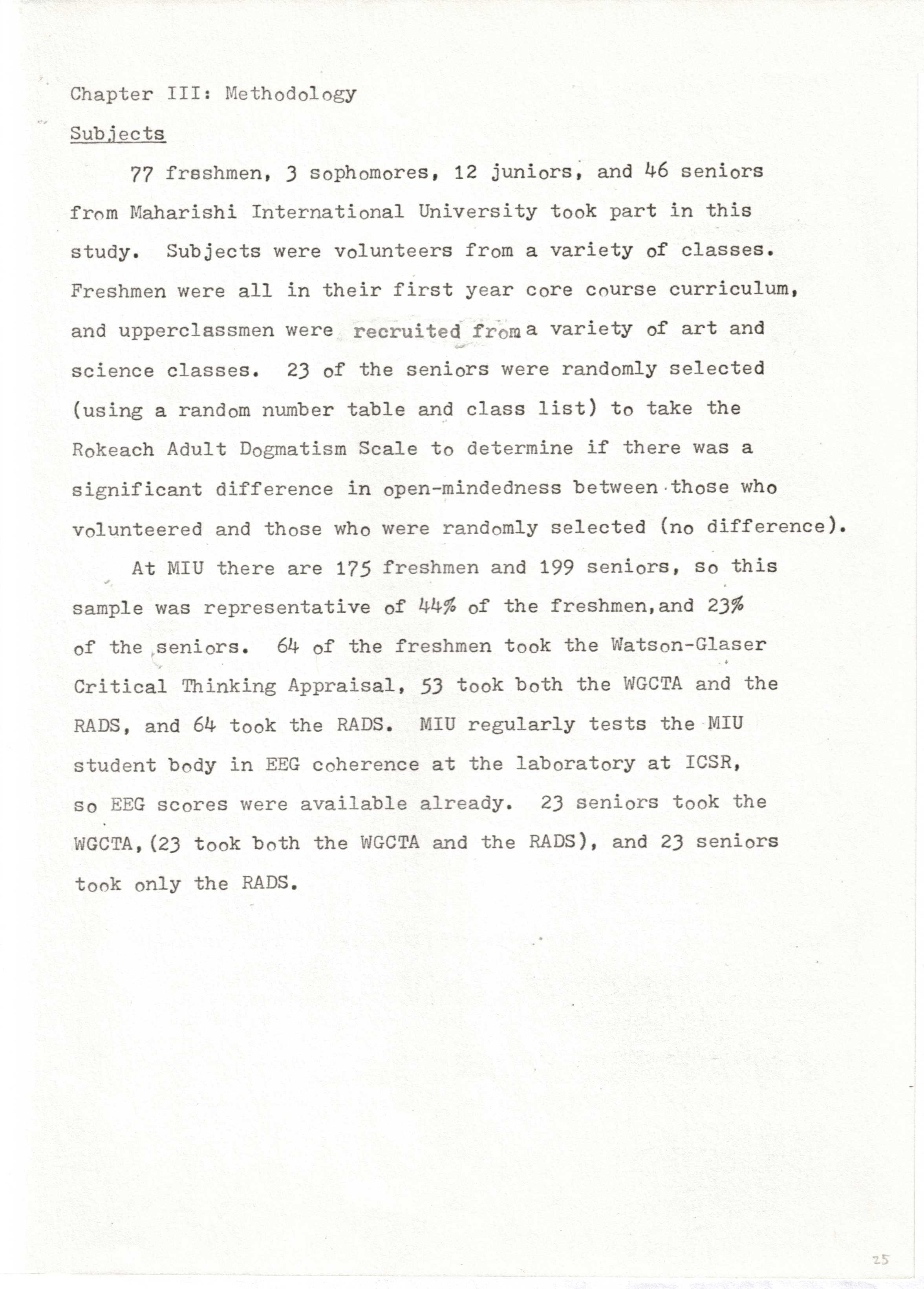
ctomeegmiu25.jpg
|
Chapter III: Methodology Subjects
77 freshmen, 3 sophomores, 12 juniors, and 46 seniors
from Maharishi International University
took part in this
study. Subjects were volunteers from a
variety of classes.
Freshmen were all in their first year core
course curriculum,
and upperclassmen were recruited
from a variety of art and
science classes. 23 of the seniors were
randomly selected
(using a random number table and class
list) to take the
Rokeach Adult Dogmatism Scale to determine
if there was a
significant difference in open-mindedness
between those who
volunteered and those who were randomly selected (no difference).
At MIU there are 175 freshmen and 199
seniors, so this
sample was representative of 44% of the
freshmen, and 23%
of the seniors. 64 of the freshmen took the
Watson-Glaser
Critical Thinking Appraisal, 53 took both
the WGCTA and the
RADS, and 64 took the RADS. MIU regularly
tests the MIU
student body in EEG coherence at the
laboratory at ICSR,
So EEG scores were available already. 23
seniors took the
WGCTA, (23 took both the WGCTA and the RADS). and 23 seniors
took only the RADS. |
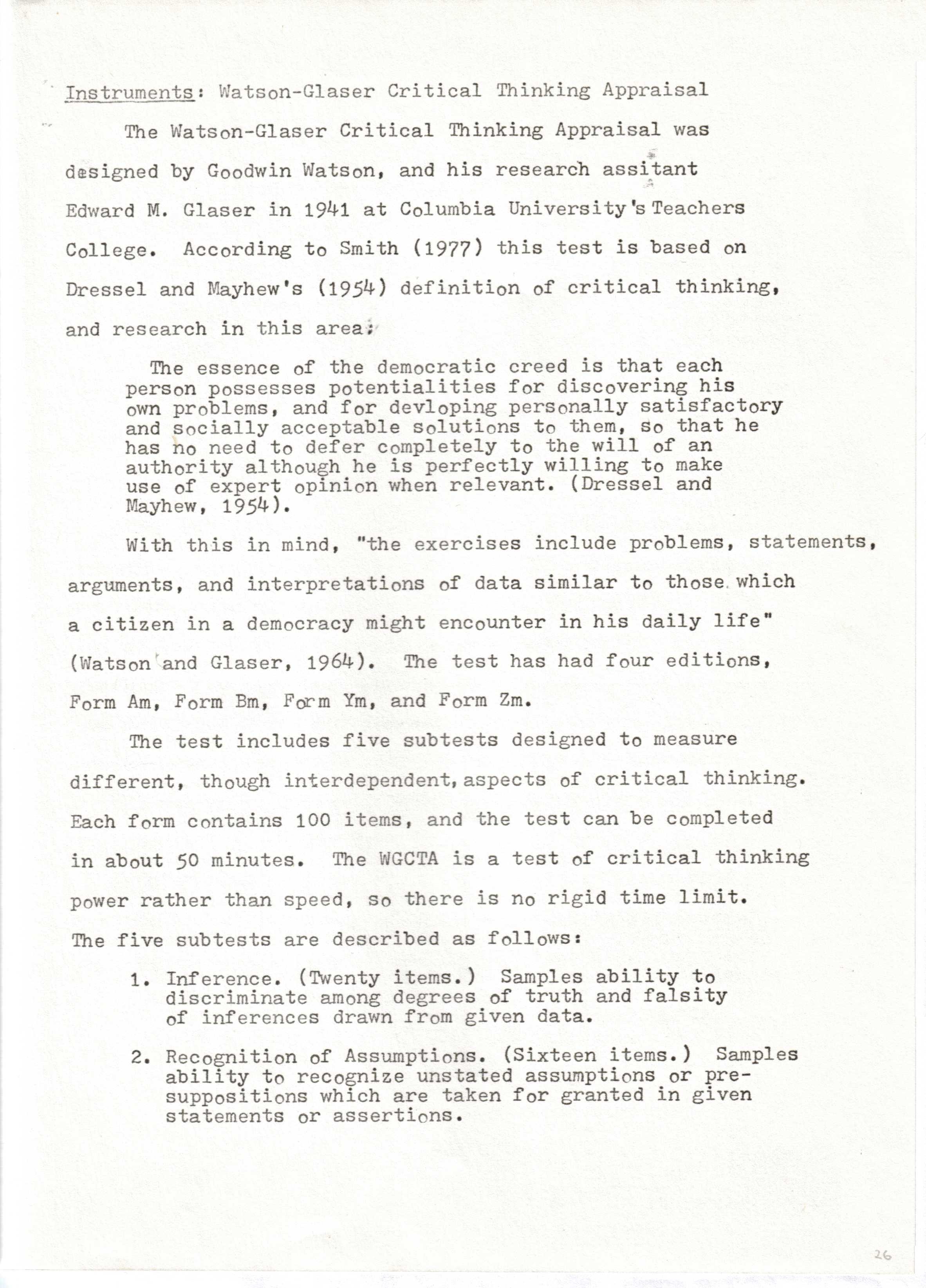
ctomeegmiu26.jpg
|
Instruments: Watson-Glaser Critical
Thinking Appraisal
The Watson-G1aser Critical Thinking
Appraisal was
designed by Goodwin Watson, and his
research assistant
Edward M. Glaser in 1941 at Columbia
University & Teachers
College. According to Smith (1977) this
test is based on
Dressel and Mayhew's (1954) definition of
critical thinking,
and research in this area:
- The essence of the democratic creed is that
each
person possesses potentialities for
discovering his
own problems, and for developing personally
satisfactory
and socially acceptable solutions to them,
so that he
has no need to defer completely to the will
of an
authority although he is perfectly willing
to make
use of expert opinion when relevant.
(Dressel and
Mayhew, 1954).
With this in mind, "the exercises include
problems, statements,
arguments, and interpretations of data
similar to those which
a citizen in a democracy might encounter in his daily life"
(Watson and Glaser, 1964). The test has had
four editions,
Form Am, Form Bm, Form Ym, and Form Zm.
The test includes five subtests designed to
measure
different, though interdependent, aspects of
critical thinking.
Each form contains 100 items, and the test
can be completed
in about 50 minutes. The WGCTA is a test of
critical thinking
power rather than speed, so there is no
rigid time limit.
The five subtests are described as follows:
- 1. Inference. (Twenty items.) Samples
ability to
discriminate among degrees of truth and
falsity
of inferences drawn from given data.
-
- 2. Recognition of Assumptions. (Sixteen
items.) Samples
ability to recognize unstated assumptions
or pre-suppositions which are taken for granted in
given
statements or assertions.
|
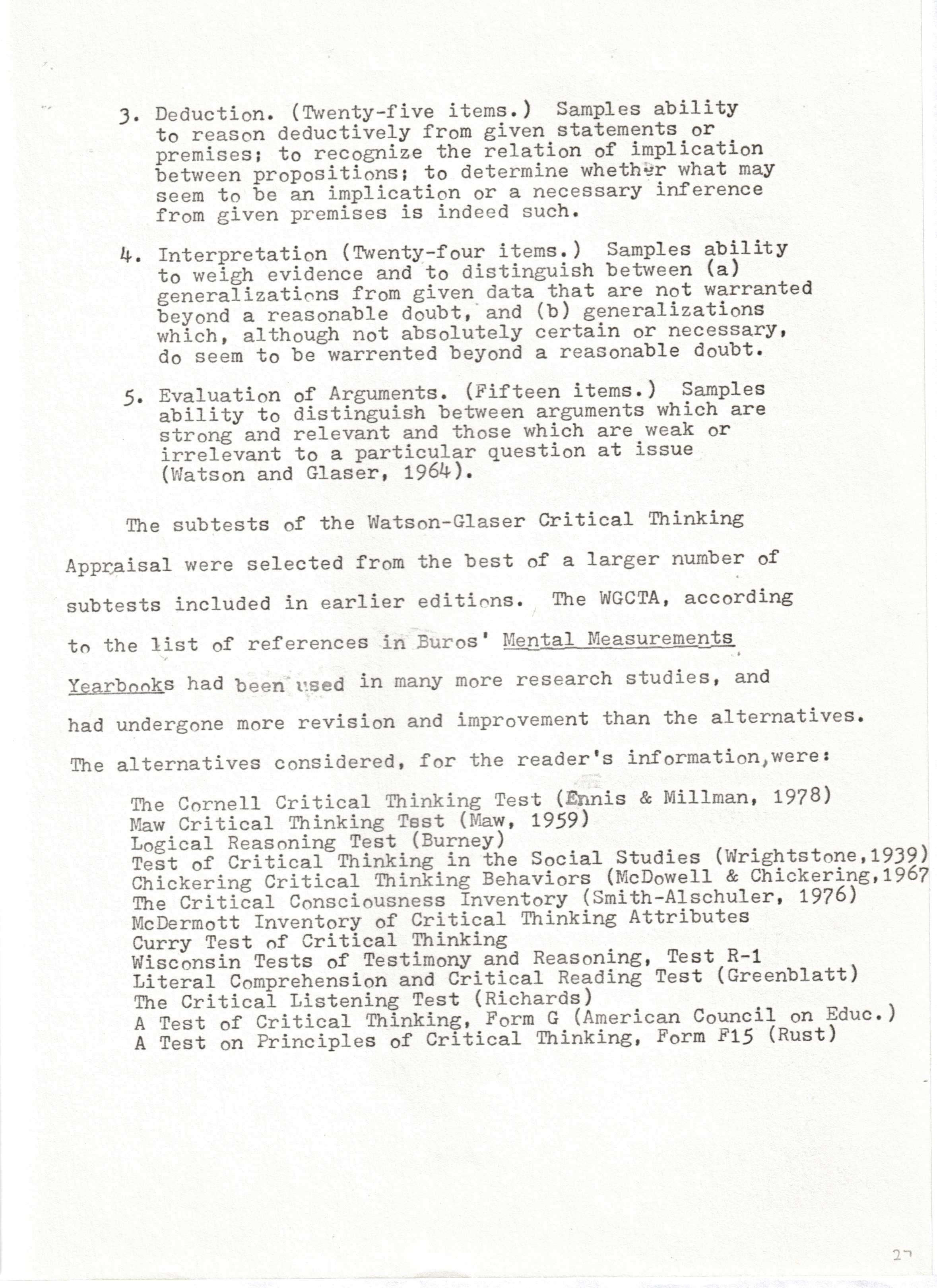
ctomeegmiu27.jpg
|
-
3. Deduction. (Twenty-five items.) Samples
ability
to reason deductively from given statements
or
premises: to recognize the relation of implication
between propositions: to determine whether
what may
seem to be an implication or a necessary inference from given premises is indeed
such.
-
- 4. Interpretation (Twenty-four items.)
Samples ability
to weigh evidence and to distinguish
between (a)
generalizations from given data that are
not warranted
beyond a reasonable doubt, and (b)
generalizations
which, although not absolutely certain or
necessary
do seem to be warranted beyond a reasonable doubt.
-
- 5. Evaluation of Arguments. (Fifteen
items.) Samples
ability to distinguish between arguments which are
strong and relevant and those which are weak or
irrelevant to a particular question at issue
(Watson and Glaser, 1964).
The subtests of the Watson-Glaser Critical Thinking
Appraisal were selected from the best of a larger number of
subtests included in earlier editions. The
WGCTA, according
to the list of references in Euros' Mental
Measurements
Yearbooks had been used in many more
research studies, and
had undergone more revision and improvement
than the alternatives.
The alternatives considered, for the
reader's information, were:
The Cornell Critical Thinking Test (Ennis &
Millman, 1978)
Maw Critical Thinking meet (new, 1959)
Logical Reasoning Test (Burney)
Test of Critical Thinking in the Social Studies (Wrightstons.1939)
Chickering Critical Thinking Behaviors (McDowell & Chickering,1967
The Critical Consciousness Inventory
{Smith-Alschuler, 1976)
McDermott Inventory of Critical Thinking
Attributes
Curry Test of Critical Thinking
Wisconsin Tests of Testimony and Reasoning,
Test R-1
Literal Comprehension and Critical Reading
Test (Greenblatt)
The Critical Listening Test (Richards)
A Test of Critical Thinking, Form G
(American Council on Educ.)
A Test on Principles of Critical Thinking, Form F15 (Rust)
|
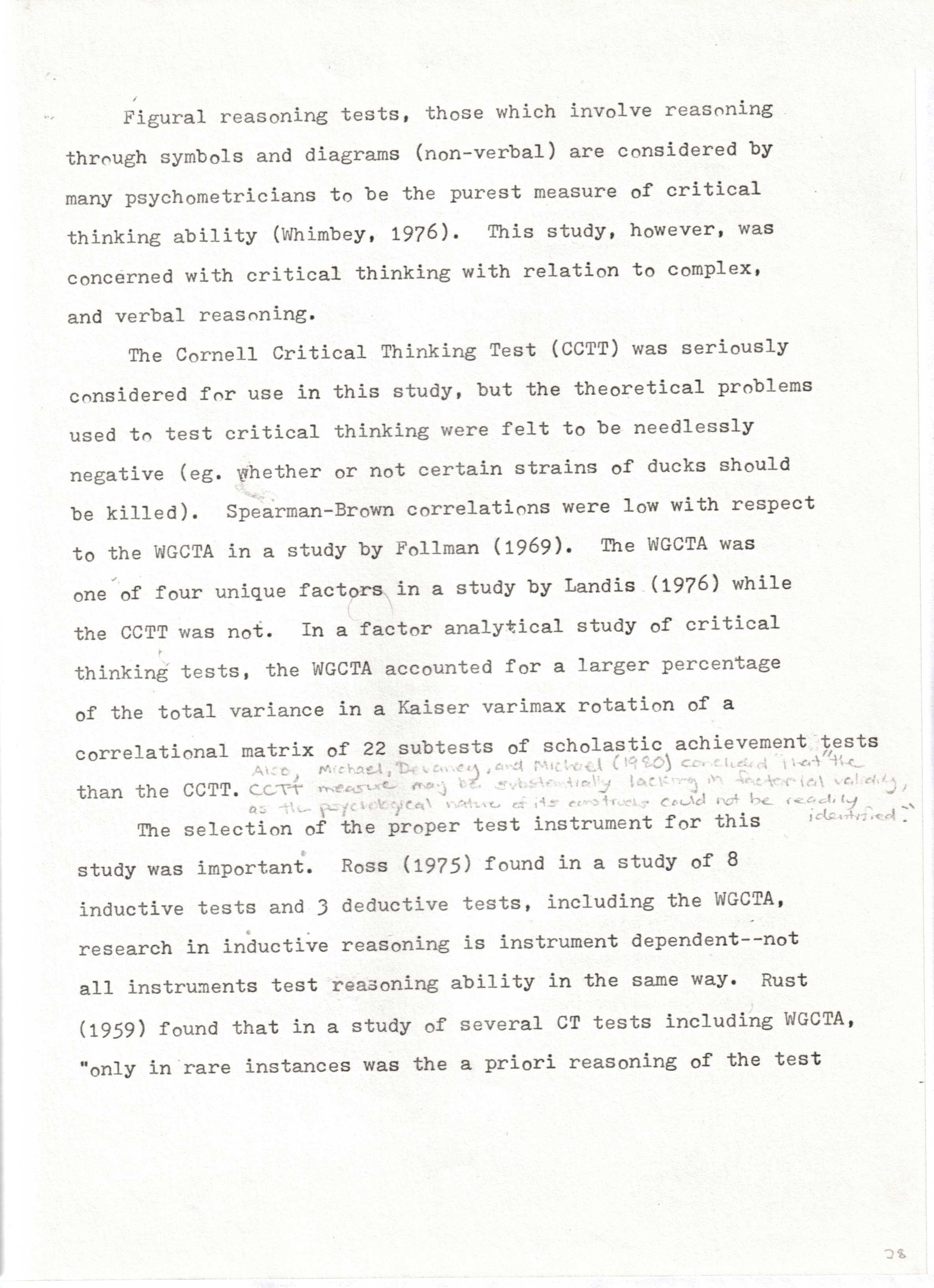
ctomeegmiu28.jpg
|
Figural reasoning tests, those which
involve reasoning
through symbols and diagrams (non—verbal) are considered by
many psychometricians to be the purest
measure of critical
thinking ability (Whimbey, 1976). This study, however, was
concerned with critical thinking with
relation to complex,
and verbal reasoning.
The Cornell Critical Thinking Test (CCTT)
was seriously
considered for use in this study, but the
theoretical problems
used to test critical thinking were felt to
be needlessly
negative (eg. whether or not certain strains of ducks should
be killed). Spearman—Brown correlations
were low with respect
to the WGCTA in a study by Follman (1969).
The WGCTA was
one of four unique factors in a study by Landis (1976) while
the CCTT was not. In a factor analytical study of critical
thinking tests, the WGCTA accounted for a
larger percentage
of the total variance in a Kaiser varimax
rotation of a
correlational matrix of 22 subtests of
scholastic achievement tests
than the CCTT.
Michael, Devaney, and Michael (1980) concluded that
"the CCTT measure may be substantially lacking in factoral validity, as the
psychological nature of its constructs could not be readily identified."
The selection of the proper test instrument for this
study was important. Ross (1975) found in a study of 8
inductive tests and 3 deductive tests,
including the WGCTA,
research in inductive reasoning is
instrument dependent--not
all instruments test reasoning ability in
the same way. Rust
(1959) found that in a study of several CT
tests including WGCTA,
”only in rare instances was the a priori
reasoning of the test |
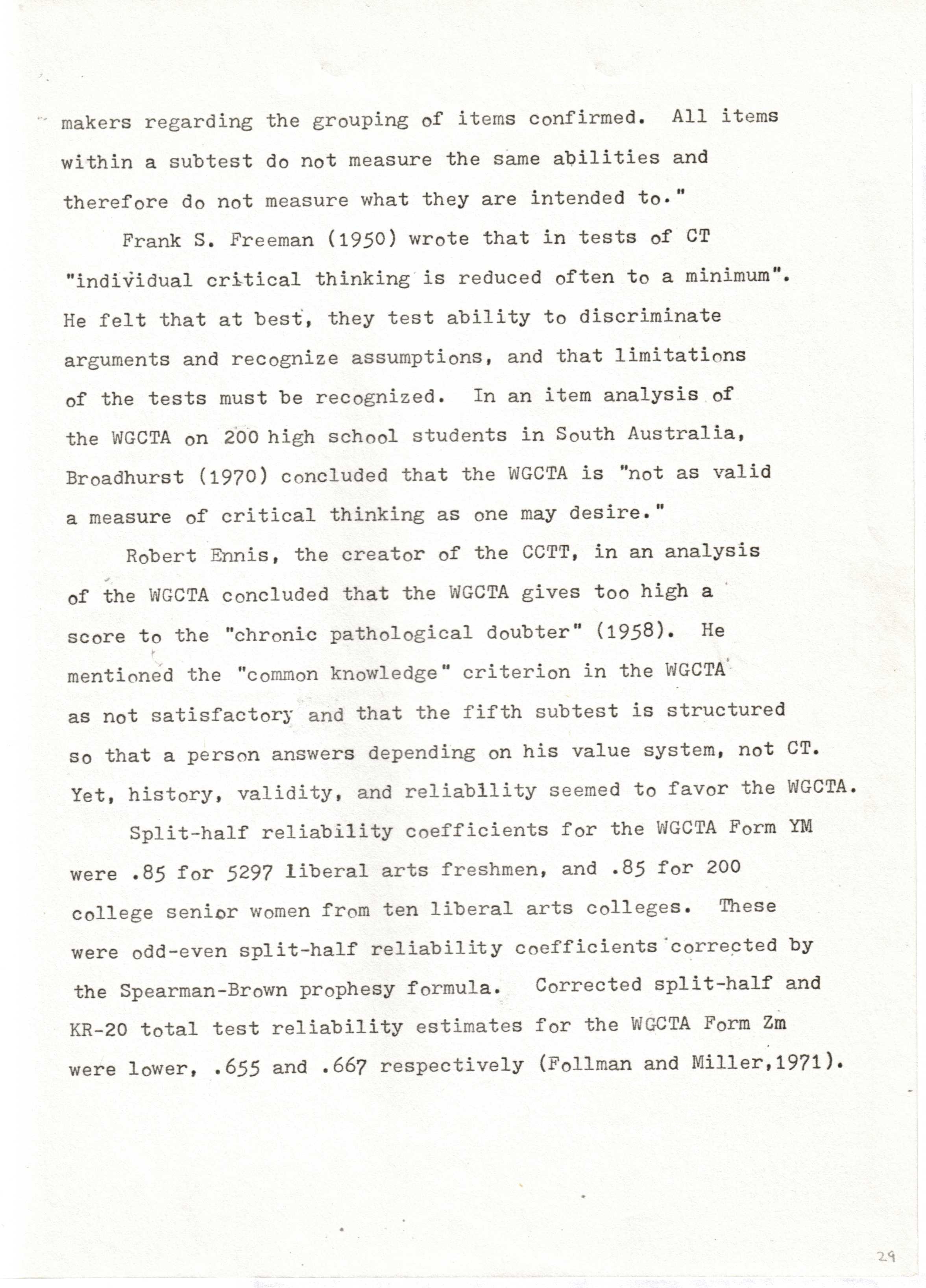
ctomeegmiu29.jpg
|
makers regarding the grouping of items
confirmed. All items
within a subtest do not measure the same
abilities and
therefore do not measure what they are
intended to." Frank S. Freeman (1950) wrote that in tests
of CT
“individual critical thinking is reduced
often to a minimum".
He felt that at best, they test ability to
discriminate
arguments and recognize assumptions, and
that limitations
of the tests must be recognized. In an item
analysis of
the WGCTA on 200 high school students in
South Australia,
Broadhurst (1970) concluded that the WGCTA
is ”not as valid
a measure of critical thinking as one may
desire.”
Robert Ennis, the creator of the CCTT, in
an analysis
of the WGCTA concluded that the WGCTA gives
too high a score to the "chronic pathological
doubter" (1958). He mentioned the “common knowledge"
criterion in the WGCTA
as not satisfactory and that the fifth
subtest is structured
so that a person answers depending on his
value system, not CT.
Yet, history, validity, and reliability
seemed to favor the WGCTA.
Split-half reliability coefficients for the
WGCTA Form YM
were .85 for 5297 liberal arts freshmen,
and .85 for 200
college senior women from ten liberal arts
colleges. These
were odd-even split-half reliability
coefficients corrected by
the Spearman-Brown prophesy formula.
Corrected split-half and
KR-20 total test reliability estimates for
the WGCTA Form Zm
were lower, .655 and .667 respectively
(Follman and Miller,1971).
|
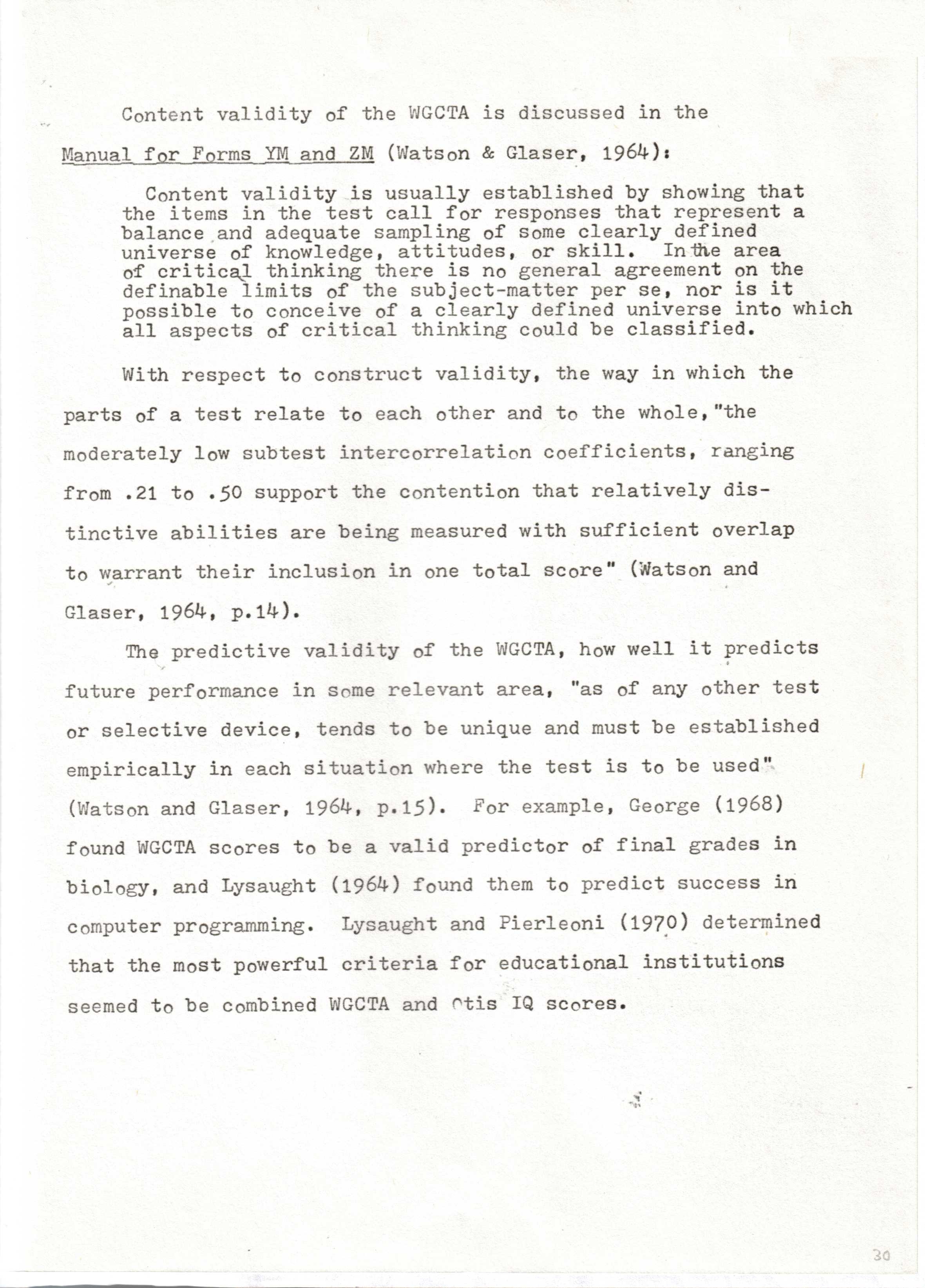
ctomeegmiu30.jpg
|
Content validity of the WGCTA is discussed
in the Manual for Forms YM and ZM (Watson &
Glaser, 196M):
- Content validity is usually established by
showing that
the items in the test call for responses
that represent a
ba1ance and adequate sampling of some
clearly defined universe of knowledge, attitudes, or skill.
In the area
of critical thinking there is no general
agreement on the
definable limits of the subject-matter per
se, nor is it
possible to conceive of a clearly defined
universe into which
all aspects of critical thinking could be
classified.
With respect to construct validity, the way
in which the
parts of a test relate to each other and to
the whole, "the
moderately low subtest intercorrelation
coefficients, ranging from .21 to .50 support the contention that
relatively distinctive abilities are being measured with
sufficient overlap
to warrant their inclusion in one total
score" (Watson and Glaser, 1964. p.14).
The predictive validity of the WGCTA, how
well it predicts
future performance in some relevant area,
"as of any other test
or selective device, tends to be unique and
must be established
empirically in each situation where the test is to be used"
(Watson and Glaser, 1964, p.15). For
example, George (1968)
found WGCTA scores to be a valid predictor of final grades in
biology and Lysaught (1964) found them to
predict success in
computer programming. Lysaught and
Pierleoni (1970) determined
that the most powerful criteria for
educational institutions
seemed to be combined WGCTA and Otis IQ
scores. |